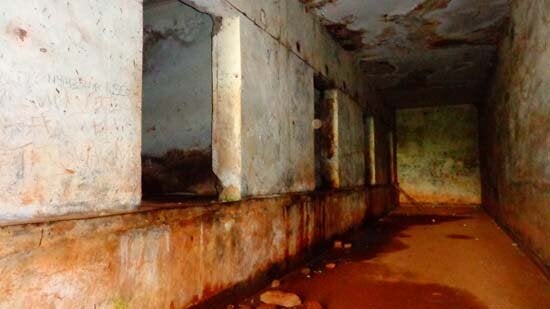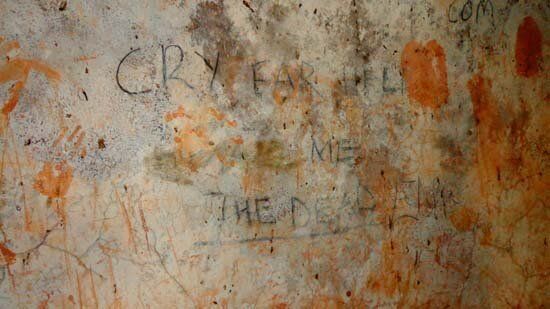
In Nyamata, a small, dusty town in southern Rwanda, there lies a tidy, red brick church. Its walls are riddled with bullet holes. The interior holds bloody smears on the floor, torn clothing neatly piled on benches, and rows of bones. They are memorials for the dead, victims of the rampaging genocidaires. In Vietnam, the Hoa Lo Prison, nicknamed the Hanoi Hilton by American prisoners of war, still has the original shackles and torture instruments on display.
But Idi Amin's torture chambers are something different altogether.

For one, there is no signs orienting or directing a visitor through the over-grown grass toward the desolate cement chamber where Amin's secret police went about their brutal business. Secondly, there is no museum-style narrative that deconstructs or interprets the site, located on the spacious Mengo Palace grounds, the home of the Buganda King.
Oddly, the torture chambers are behind some shacks; chickens run about freely. There, the ground suddenly slopes downwards into a narrow cement tunnel with four rooms on a platform. It is surprisingly small and spare for an infamous torture chamber. A Ugandan who joined me as I searched for the chambers told me that the three rooms that housed the prisoners were on a platform to prevent escape -- the lower channel was filled with water and electrified. The trapped prisoners, often hundreds crammed into a 10-by-10 foot room, had a choice of dying by electrocution by jumping into the water or at the hands of Amin's soldiers. Many, though, simply died due to asphyxiation from the sheer mass of bodies jammed into the cells.

The water has gone, the cement is wearing away. As I climbed the rickety makeshift steps into one of the tiny rooms, I was plunged into darkness. There are no lights to illuminate the room. As I turned on my cellphone to see, I realized why. The walls were covered in messages of despair, written in blood and dirt. One reads: (sic) "Cry Far Help Me The Dead". Others are simply handprints, a stark reminder of those who once lived.


How countries remember trauma and violence says so much about their ability to confront and heal the past. In Rwanda, reminders of the genocide are everywhere, marked by fluttering purple and white flags. Vietnam remembers its Hoa La prison as a symbol of both colonial violence and Viet Cong benevolence. In contrast, Idi Amin's torture chambers are neglected, the grim legacy of the place left to the vagaries of time.
The lack of attention to the sins of the past might have also something to do with the nation's conflicted feelings toward a despot once described as "certifiably mad" and "ruthless". But consider that nearly 80 per cent of the population was born well after 1979, the year Idi Amin went into exile. The visceral quality and enormity of his brutality has perhaps dimmed in the public consciousness. Compounding this with a growing cynicism over President Yoweri Museveni's failure to transform Uganda, and Amin may be cast in a slightly more sympathetic light: yes, Amin was despotic and violent, but at least he was open about it. The Daily Monitor, for instance, argued that Amin simply wanted to be "the president of Ugandans and for Ugandans. The Monitor said he was "trying to be true to his own people ... undid all the goodwill he had enjoyed in the West and Israel."
Perhaps Ugandans don't want to remember the enormity of Idi Amin's crimes (between 100,000 to 500,000 were killed in eight years) because it will remind them of how, in so many ways, Uganda has not lived up to its potential. Uganda celebrates its 50th anniversary this year and the celebration is shrouded in a pessimistic miasma over the direction the country has taken. The dysfunction of the country is laid bare in the news: Makerere University, once the best in the region, is now facing investigation for mismanagement of funds; parts of the country remains cut off due to flooding and poor roads; the government spent $72-million on national ID cards but only 400 citizens received the cards. Uganda was recently deemed to be the most corrupt country in East Africa.
It is not as though great strides have not been made in Uganda. Uganda can rightfully celebrate the end of the war. And winning its first Olympic gold medal in 40 years! However, as it looks increasingly unlikely that President Museveni, who has ruled continuously since 1986, will step down, maybe Uganda hasn't come that far after all. If the dead, tortured and the exiled are not remembered, Uganda risks forgetting the messages left by the lonely handprints on the decaying cement wall.